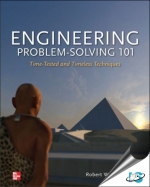Tab Article
MASTER UNIVERSAL ENGINEERING PROBLEM-SOLVING TECHNIQUES
Advance your engineering skills and become a capable, confident problem solver by learning the wide array of tools, processes, and tactics employed in the field. Going far beyond "plug-and-chug" solutions, this multidisciplinary guide explains the underlying scientific principles, provides detailed engineering analysis, and lays out versatile problem-solving methodologies.
Written by an "engineer who teaches," with more than 20 years of experience as a practicing engineer and numerous awards for teaching engineering, this straightforward, one-of-a-kind resource fills a long-vacant niche by identifying and teaching the procedures necessary to address and resolve any problem, regardless of its complexity. Engineering Problem-Solving 101: Time-Tested and Timeless Techniques contains more than 50 systematic approaches spanning all disciplines, logically organized into mathematical, physical/mechanical, visual, and conceptual categories. Strategies are reinforced with practical reference tables, technical illustrations, interesting photographs, and real-world examples.


